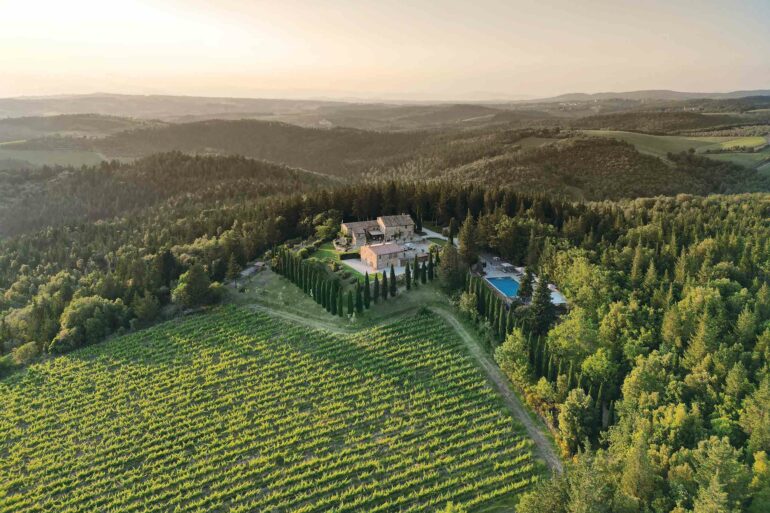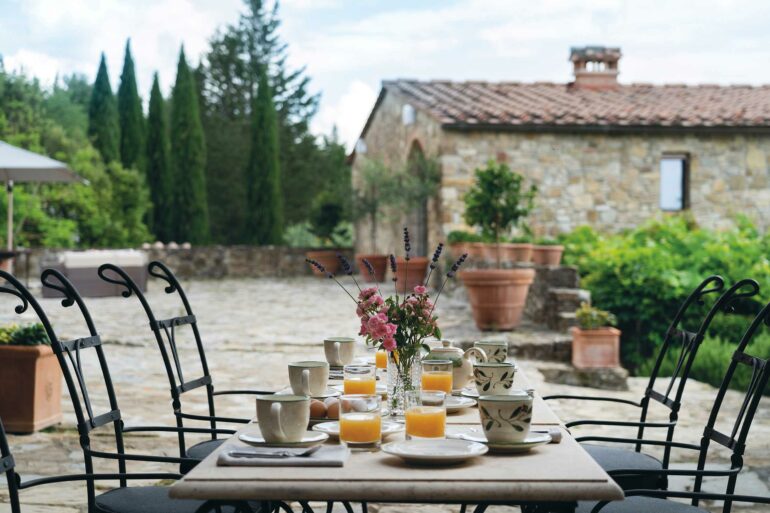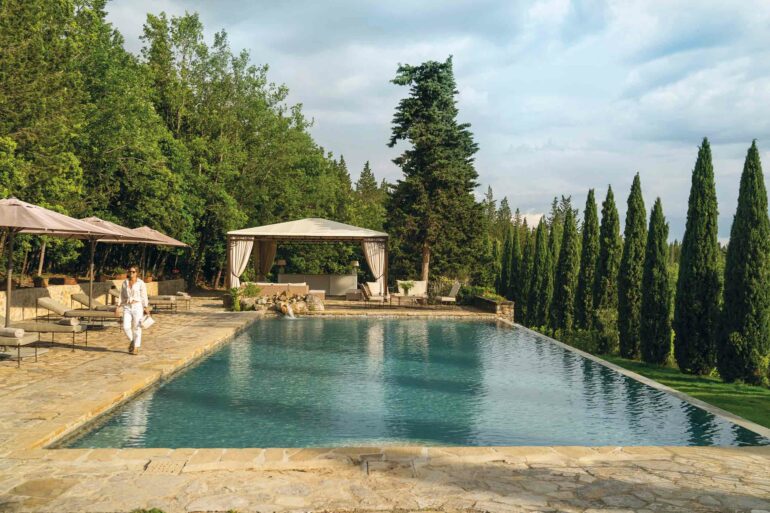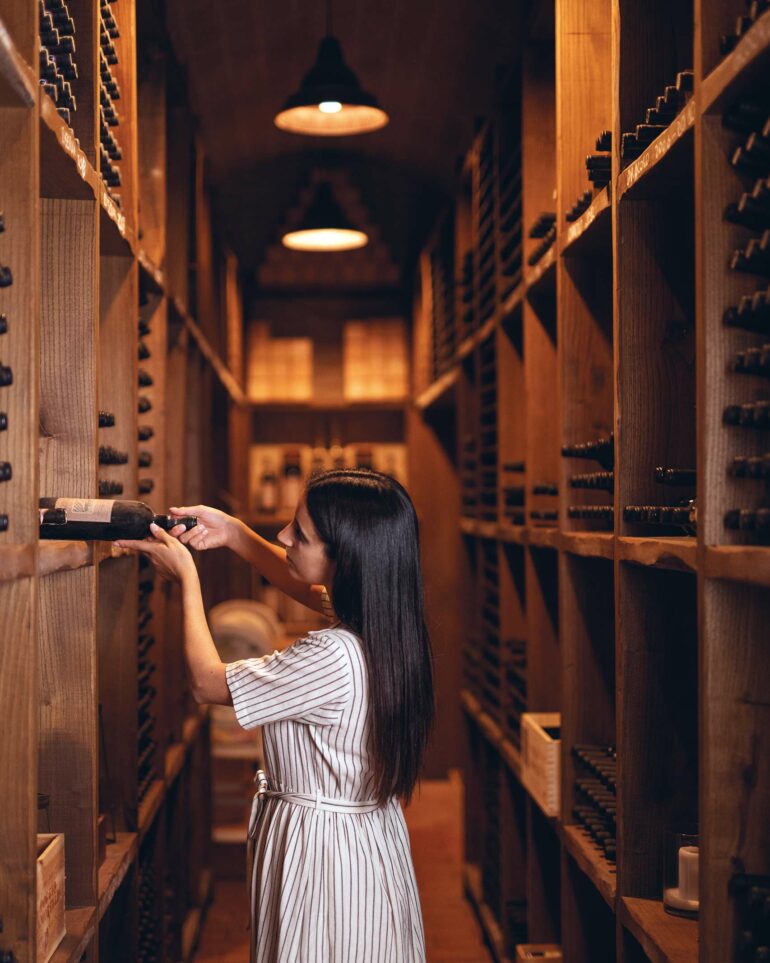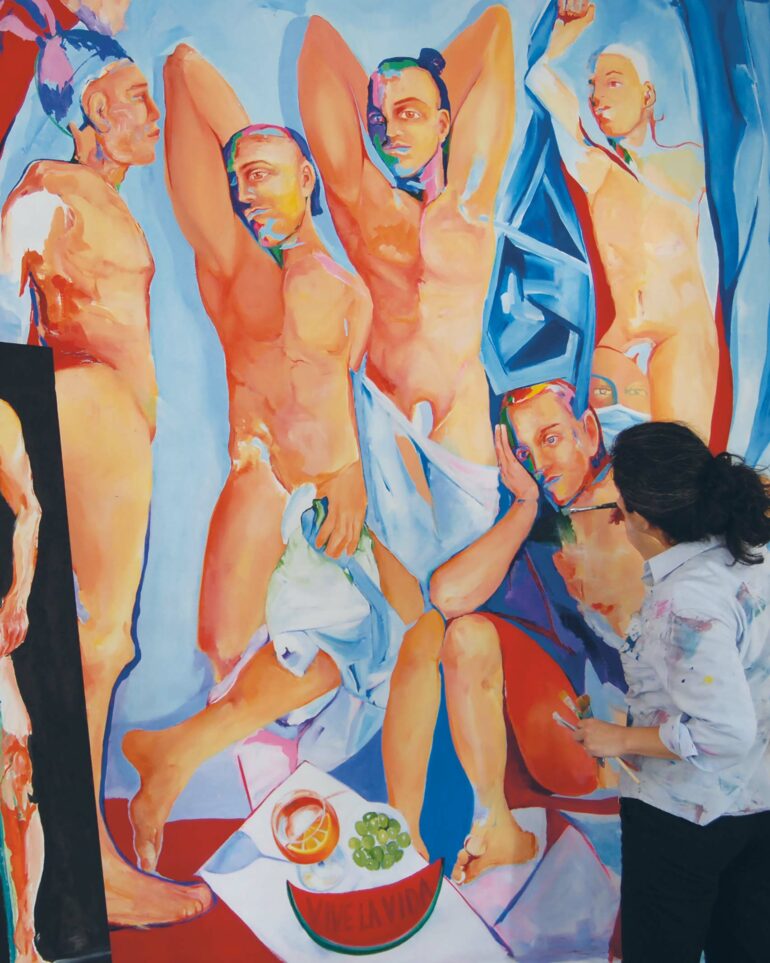Beginning to explore their Italian roots a decade ago, LA couple Stephen Lewis and Christian Scali fell so hard for Tuscany they poured years and millions into creating the home of their dreams high on a Chianti hilltop: Villa Ardore. We believe their guests will feel just as bewitched.
In September 2007, Stephen Lewis, then a lawyer serving as counsel to West Hollywood, submitted on behalf of a coalition of 19 Californian cities and counties a 50-page brief to the state’s Supreme Court, one of hundreds of lawyers’ briefs aimed at persuading the court to grant full marriage rights and status to same-sex couples. Citing cases of persecution of gays from Ancient Rome and the Knights Templar to Oscar Wilde, Stephen’s impassioned argument took the unusual angle that the refusal to grant full marriage parity, as he now explains it, ‘perpetuated millennia of invidious discrimination’. His was one of three briefs later singled out by the judge as especially instrumental in the court’s decision to at last grant those rights, in May 2008.
Despite this historic win, Stephen and his long-term partner Christian Scali found themselves planning their own wedding in haste a few short months later. Conducted in both of their lunch breaks, with just Stephen’s boss and one of Christian’s cousins attending, it was a shotgun wedding of sorts, the firearm in question being Proposition 8, a ballot proposition aiming to block the new rights, which soon after effected a ban on same-sex marriage that wasn’t overturned until June 2013.
Around that time, Stephen and Christian were igniting a new lifelong passion – for Italy. Both of Italian descent, they took their first trip to their ancestral land in 2013. And while they loved Venice and Rome, it was Florence and the region of Tuscany that made the most soul-stirring impression.
“The architecture, the art, the history,” says Christian, a dreamy, first-crush look lighting his face. “But also the way of life. Florence has hordes of tourists, of course, but still feels like a real city with an interesting contemporary culture. We fell in love with it on our first trip. And very quickly we started to make good friends there.”
‘La Bella’ inspired many return visits over the following years, during which they explored more of the region and built up a circle of Tuscan contacts. Then came the 2016 US election.
“Around that time we started thinking about where we wanted to retire,” says Christian, “and, not really knowing what was going on with our country, thought about moving abroad. Stephen’s a real anglophile. He studied at the University of Lancaster in the UK and if we weren’t going to retire here, he’d have wanted to move to the north of England. But I usually get my way… and he agreed to start looking in Florence.”

This story first appeared in The Experientialist Awards Issue, available in print and digital.
Subscribe today or purchase a back copy via our online shop.
Finding apartments in the city eye-wateringly expensive, they broadened their search, taking in rural villas, farmhouses, and even a dilapidated castle or two. Meanwhile, the idea took root of creating not just a home for themselves with enough space to welcome visitors comfortably, but a hospitality business they could share with a bigger audience, which would help support them into their retirement.
They viewed around 30 properties and were well on their way to buying another villa when, almost by chance, in 2021 they discovered a down-at-heel bed and breakfast perched on one of Tuscany’s highest hills, close to the tiny medieval town of Castellina in Chianti, in the heart of the world-famous wine region. And both quickly felt that, in this former 16th-century farmhouse, once a lookout in the days when Florence and Siena, both less than an hour away today, were perma-feuding republics, they’d found ‘the one’.
“We drove along a long, high gravel road through the forest and came to a rickety old gate you had to hold up when you opened it so it wouldn’t fall,” Stephen recalls. “Then, passing beneath a tunnel-like canopy of trees, we came out into this open vista, with a spectacular view across neat rows of grapevines to the medieval towers of San Gimignano and the hills in the distance. It was an almost cinematic moment: raw beauty, with some ineffable quality about it.
“The building itself looked nothing like it does now. It was dowdy, but there was something about the thick stone walls and variety of views from different rooms – some grand, some cosy – and how the various parts of the property had different feels to them. Even though the other place we were buying ticked all the boxes, it just didn’t have the emotional pull this did. This old farmhouse had such a feeling of being a home.”
An 18-month, $2.5m renovation later, Stephen, who’s now a screenwriter, and Christian have transformed the property into Villa Ardore, a quietly dazzling holiday home for exclusive private hire. Set in 1.5 hectares of beautifully landscaped, established gardens with an 18m (60ft) saltwater infinity pool framed by a row of elegant cypresses, tended lawns and generous stone terraces, the converted farmhouse and barn together offer eight generous ensuite bedrooms across two buildings, and deftly combine world-class contemporary luxury with its owners’ deep love of authentic, rustic Tuscan culture.
On my visit, my car climbs the same strada bianca – an unpaved ‘white road’ named for its limestone gravel surface and a signature feature of local landscapes – that Stephen and Christian took in 2021. Piles of cut logs line the way, the product of the thinning of the untamed surrounding forest that takes place every 10 years to guard against fires, and through whose trees honey-coloured afternoon sunshine strobes. The sense of seclusion is heady, the beauty of this unusually rugged part of Tuscany, a touch wilder than the region’s postcard-familiar patchworks of vineyards and olive groves elsewhere, enthralling.
I’m greeted with Prosecco and a hug by villa manager Francesco ‘Franci’ Goracci and, before being amiably hurried away from a chat with Christian for a ‘welcome massage’ beneath the draped poolside gazebo (a well-stocked bar comfortingly just steps away), I discover Franci is the first friend Stephen and Christian made in Florence, when he and his partner Massi served them drinks at the gay bar Piccolo Cafè. Their partner in Tuscan revelries ever since, Franci talked excitedly about his and Massi’s imminent first visit to the US, where Stephen and Christian have invited them to their home in the Los Feliz neighbourhood of LA. And while Franci is always available to help guests fine-tune plans made before their visit with the villa’s US-based personal Tuscany stay planner and fulfil arising requests, the service and staffing levels are entirely as guests choose, from absolute privacy to five-star-hotel-style ministrations – or anywhere on the spectrum between.
“We have two wells on the property and recently had a diviner find a water source for a third. And we’re installing a greywater system for irrigation so we won’t use any public water. Next year we’ll put in photovoltaic panels so we’ll be solar-powered”
The meaning of the name ‘Ardore’ is twofold. It’s both the Italian word for passion, and the name of the tiny Calabrian town Christian’s grandparents’ family came from. And the couple’s ardour, both for the Italian heritage they are still discovering and for creating a lavishly comfortable and handsome home, is writ large in the property’s every detail.
Stephen and Christian’s approach to the ambitious renovation was energetically hands-on, and they drew on experience gained from remodelling their three consecutive homes in LA, where they still live and work, personally sourcing the antiques and vintage and contemporary artworks – most available for guests to buy – that give each room a distinctive look. In the large, primrose-yellow living room, a colourful 2x2m (6½x6½ft) male nude by Fabiola Quezada, a Mexican feminist artist who has lived locally for 30 years, hangs above an elegant dark-wood side table Stephen found in an Umbrian antique store. The brazier in the huge stone fireplace, which Christian designed, hails from a medieval castle. Nearby is a reclaimed, ornately carved Parisian bar, and behind it a custom-built, state-of-the-art wine cellar housing some 500 meticulously curated Italian varieties. Meanwhile, in the dining room, contemporary fine-art photography shares wall space with antique architectural engravings of Renaissance buildings, and muscular abstract sculptures carved from charred oak by Siena-based artist Filippo Galgani are found in various cannily chosen spots around the villa.
Bedrooms, some with private balcony terraces, blend quietly 21st-century comforts, such as hand-tufted St Regis mattresses dressed in sheets from Paris’s oldest luxury-linens producer Yves Delorme, air con and underfloor heating, with rugged original roof beams, exposed ancient stone walls and more one-off antique-shop finds. Between them, the villa’s bathrooms lavishly showcase four kinds of marble, one of them now officially extinct and extremely rare, thanks in part, says Christian, to the avaricious hoarding of the Vatican.
It’s an aesthetic whose faithful reflection of local traditions, Christian tells me, is unusual in the Tuscan luxury villa market. Renovation to such standards typically ushers in a more generic, internationalized look. “Like the Four Seasons in Tuscany,” he says, with half an amused eye-roll. “Along with all the other Four Seasons.”
Recognising this taste, and that in the shell of the imposing stone barn they had been gifted more of a blank canvas, he and Stephen commissioned the pre-eminent Florence architectural practice Massimo Pierattelli to create two supersized contrasting suites with more modern finishes and proportions. This also allowed them to furnish one suite with a galley kitchen and accessible bathroom, and build a professional catering kitchen (one of two at the villa) on the lower ground floor.
Unusual, too, in the sector is the inclusion of a private spa, in Villa Ardore’s case a sleek, hotel-standard sanctuary, also in the converted barn. This boasts a sauna, eucalyptus steam room, ‘sensory shower’ and – centre-stage – a 10-person sunken hot tub between original stone walls, with a view through large glass doors of that million-dollar, cinematic view. Spa treatments with expert local practitioners are available on request.
Stephen and Christian are proud too to be pioneers in the area in sustainable building management. “We have two wells on the property,” says Christian, “and recently had a diviner find a water source for a third, and are installing a greywater system for irrigation so we won’t use any public water. Next year we’ll put in photovoltaic panels so we’ll be solar-powered. In the renovation, we used reclaimed wood and locally sourced stone. And these,” he says, leading me to a large chicken coop in the gardens, “are the ladies of Villa Ardore, who lay eggs for our guests’ breakfast. We have nine chickens, and one black rooster, Cosimo, chosen to reflect the traditional emblem of Chianti. Cosimo is basically a sex worker.”
“The kind of guests we’re looking for increasingly want exclusive experiences that have a connection to the area”
Beautiful shared spaces are plentiful, too, from the capacious central terrace, perhaps the best sunset-viewing spot on the whole property, with its firepit, to the generous poolside areas with cocktail bar and gazebo, to the large indoor and outdoor communal dining areas, the latter set up with its own wood-fired pizza oven, regularly used to guests’ delight by pizzaiolo Gianluca, owner of Pizzeria del Borgaccio in nearby Poggibonsi (don’t miss his inspired carbonara variety).
Another signature feature is a huge menu of bespoke experiences, both in-villa and in the surrounding area, that guests can choose to build into their trip. And, as the video on the villa’s website homepage proudly announces, among these are achingly romantic wedding celebrations, for both same- and mixed-sex couples.
Despite the significance of weddings in the owners’ lives, this wasn’t something they had planned from the project’s outset.
“As we were renovating the property,” says Stephen, “it was becoming more and more elegant, and we started seeing a beauty in it even we had not seen at first. And at some point, it occurred to us that this would really be an amazing spot to be married in.”
And while same-sex marriage is not yet legal in Italy (although civil unions are – and same-sex relationships don’t, Christian and Stephen tell me, raise so much as an eyebrow in even rural parts of sophisticated, worldly Tuscany), a symbolic marriage celebration with friends and family, Villa Ardore-style, is rich in memorable compensations. With the capacity to host up to 60 guests, the villa offers wedding services, from hair and make-up, floristry and Michelin-standard catering to a pool-party reception, with DJ shipped in from Rome or Ibiza.
“In the course of renovating the villa, I kind of accidentally became a hospitality expert,” says Christian. “We made a friend here who manages a bunch of luxury villas, and he helped us a lot in deciding what kinds of amenities and services to offer. And the kind of guests we’re looking for increasingly want to access exclusive experiences that have an authentic connection to the area.”
Now familiar with Christian’s meticulous attention to detail – and the satisfaction its results bring him – I’m not a bit surprised to find that he threw himself into learning the art of high-end experience conciergerie with zeal. And the result is a prodigious menu of bespoke excursions, classes, indulgences and celebrations, all vetted and managed by the breezily super-capable Franci in his parallel role as Villa Ardore guests’ personal Tuscany experience curator.
Without even setting foot off the property, guests can have a custom-designed yoga and wellness programme. They can learn to make pasta or take Tuscan cookery classes with a Michelin-rated chef in the professional kitchen. Or be serenaded poolside by gay opera singer Gianluca Margheri (also a habitually shirt-averse fitness model. Just saying).
Off-site, the cultural, culinary and active choices are virtually endless, including everything from an early-morning hot-air balloon flight and road tour of medieval towns in a convoy of button-cute Fiat 500s – or, for that matter, Ferraris or Lamborghinis – to a shopping-concierge-guided, Prosecco-fuelled spree in Florence’s designer boutiques. Adventure hikes to local ruins, copious cycling and mountain-biking options and horseriding are ideal calorie-clearing activities before diving into a directory of dining choices that range from locals’ favourite low-key trattorias to Michelin-starred restaurants and a six-meat-course blowout lunch at Antica Macelleria Cecchini (slogan – ‘carne diem’), the restaurant in tiny Panzano helmed by ‘the singing butcher’ Dario Cecchini, and made world-famous by his 2019 appearance on Netflix’s Chef’s Table. Bespoke excursions can also take in any number of local festivals and events, from legendary classic-car rallies and Siena’s historic Palio horse races to Florentine men’s-fashion fair Pitti Immagine Uomo and Christian’s personal favourite, the Castellina in Chianti Pentecostal Wine Festival, which sees a huge, snaking line of dining tables set up for feasting in the vaulted gallery under this charming and little-known medieval hill town’s ancient fortified walls.
“It was a pretty big deal in West Hollywood when the Supreme Court made its decision and the city created this kind of marriage banquet in a park close to City Hall. They set up 20 or 30 beautiful tents with chandeliers hanging in them for people to get married in”
To this guest’s mind, perhaps the most exceptional feature of a Villa Ardore stay is how tangibly it has been shaped by Stephen and Christian’s deep immersion in the local community, and the feeling of being welcomed into a personal social network organically evolved over years. I leave Chianti having been invited to visit Fabiola Quezada in her stunning rural studio in a converted farm building close to Castellina in Chianti and see many works in progress while we sip aperitivos, and after a tour of the nearby Poggio Amorelli wine estate with, over a delicious lunch, wines poured to taste by members of the managing Mazzarrini family, who Stephen and Christian first met as bambini nine years ago.
I toast my last evening at the villa with an ambrosial fine-dining feast, whose menu had only been planned hours before based on the best ingredients personal chef Roberto Miceli had found in the pick of the shops and markets in the area that day.
Given their glaringly apparent gift for magical placemaking and mustering uplifting memories, I can’t help but wonder if Stephen and Christian have thought of celebrating their marital union once more, in their one-day forever home. Both, however, are more than happy with the memories they already have.
“It was a pretty big deal in West Hollywood when the Supreme Court made its decision,” Stephen recalls, “and the city created this kind of marriage banquet in a park close to City Hall. They set up 20 or 30 beautiful tents with chandeliers hanging in them for people to get married in, and there was such pent-up demand that anybody who wanted to as a city employee could become deputised to officiate at weddings. So there were people lining up to get married.
“And a couple of things made me a little teary-eyed. There was a lesbian couple, probably in their late 60s, and one of them had MS and was in a wheelchair, but since she was a little girl she had always pictured herself standing at the altar getting married and, although she could barely walk, she struggled to her feet to stand with her wife. And there were two men who had adopted kids, and the oldest, probably 11 or 12, said, ‘I never thought my daddies would be able to get married’. Even this little kid understood how amazing it was that at last there was societal recognition of the equal value of his family. So it didn’t feel like we were cheated out of something by being married in the park. In fact, I’m a little teary-eyed now.”
Photography by Fabiola Quezada, Poggio Amorelli and courtesy of Villa Ardore




